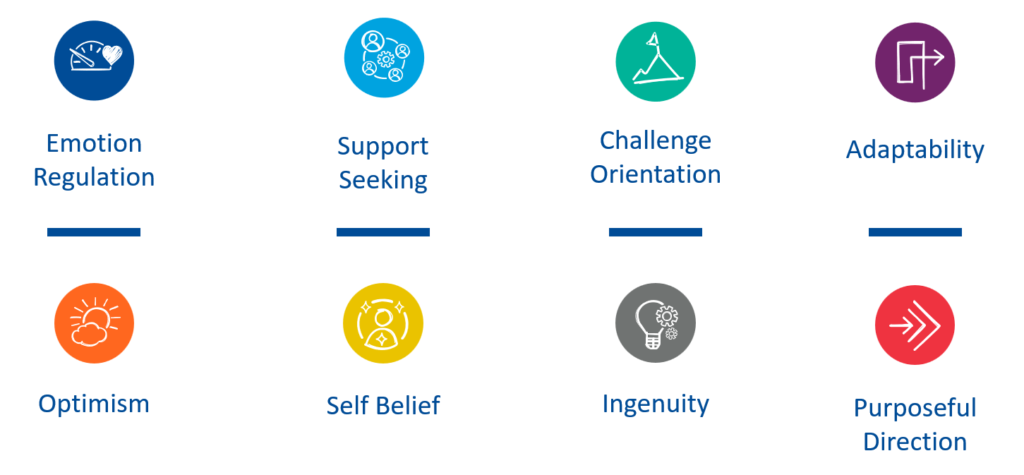In a world where change is the only constant, organizations are awakening to the undeniable truth – resilience is the secret weapon for survival and success. But what exactly does resilience mean in a team context? It’s more than just bouncing back from setbacks; it’s about harnessing individual and collective strengths, adapting to challenges, and rebounding to higher levels of success. When organizations support leaders and team members in enhancing their resilience, it fortifies their overall well-being and drives innovative strategies to solve problems and make good decisions.
What is Resilience?
Resilience is the process and outcome of successfully adapting to difficult or challenging life experiences, especially through mental, emotional, and behavioral flexibility and adjustment to external and internal demands.
– American Psychological Association
Resilience involves various components and strategies that are present in everyone to varying degrees. Unlike personality styles, our individual resilience can be improved and strengthened by practicing skills and behaviors that enhance our ability to adapt positively to pressure, setbacks, challenges, and change to optimize performance. Understanding how we are resilient, and how we can adapt to changes, will help us navigate future experiences more effectively and successfully.
The Resilience Edge
Resilience in teams has emerged as a vital competitive edge for organizations – from enhanced problem-solving capabilities to increased productivity and sustainable growth, building resilience in teams offers organizations significant benefits.
Adaptability: resilient people can adapt quickly and effectively to changing circumstances, allowing them to navigate unexpected challenges and seize new opportunities.
Better Decision-Making: resilient teams are composed of individuals who can think critically to solve problems and make informed decisions under pressure. They are skilled at weighing risks and benefits, resulting in more effective and timely decision-making.
Improved Problem Solving: resilient teams possess a problem-solving mindset, enabling them to creatively address obstacles and find innovative solutions. They thrive in complex situations and can overcome hurdles with confidence.
Enhanced Collaboration: resilience fosters a sense of unity and cooperation within teams. By encouraging open communication and trust, resilient teams can collaborate seamlessly, leveraging diverse perspectives and skills to achieve common goals.
Increased Productivity: when teams develop resilience, they are less likely to be derailed by setbacks. They maintain focus, motivation, and productivity even in the face of adversity, ensuring that projects stay on track and deadlines are met.
Higher Employee Engagement: resilient teams create an environment that promotes engagement and employee satisfaction. Through supportive relationships offering support and recognizing individual contributions, team members feel valued and empowered, leading to higher levels of commitment and loyalty.
Sustainable Growth: building physical and psychological resilience within teams sets the stage for sustainable growth and long-term success. By weathering challenges and learning from failures, teams can continuously improve and evolve, positioning the organization for future achievements.
What are the Components of Resilience?
To help organizations lay the foundation for building high-performing teams, 8 key components of resilience have been identified that hold the power to transform your business performance.
Based on a Resilience Questionnaire™ developed by Talogy, there are 8 validated components of resilience that we leverage within our raising organizational resilience workshop. Incorporating these components into your team’s culture and mindset, implementing improvement strategies, and following an actionable plan, will build the necessary skills to function as a high-performing team.

By providing a supportive framework for leaders and team members, organizations can arm their workforce with the tools necessary to be more adaptable, flexible, and optimistic when facing challenges, which will increase overall resilience and strengthen their ability to succeed in any situation.
Strategies to Build Resilience
 |
Increase Emotion Regulation |
|
|
 |
Increase Support Seeking |
|
|
 |
Increase Optimism |
|
|
 |
Increase Self Belief |
|
|
 |
Increase Challenge Orientation |
|
|
 |
Increase Adaptability |
|
|
 |
Increase Purposeful Direction |
|
|
 |
Increase Ingenuity |
|
|
Resilience is fundamental to creating high-performing teams capable of mastering life’s greatest challenges and thriving in uncertain environments. By identifying your team’s areas of strength and development, you can develop strategies to build resilience and become more agile, adaptable, and creative. Resilience is not a fixed trait that is ‘hard-wired’ in us; it’s a way of thinking. With support and practice, we can strengthen our thinking patterns, preferences, and behaviors to increase our resilience. Remember that building resilience is an ongoing process that requires commitment and a collective effort from team members and leaders alike.
How to Develop a Resilience Implementation Plan
Assess Team Resilience: conduct a resilience assessment survey to identify areas of strength and areas for improvement at an individual and collective level.
Develop a Resilience Roadmap: based on the assessment, create a plan outlining specific actions to address each component of resilience.
Provide Training and Resources: offer workshops, training sessions, and resources to help team members develop the necessary skills and resilient mindset to strengthen their resilience.
Encourage Peer Support: establish buddy systems, peer mentoring, or support groups to foster a network of support within the team.
Regularly Review Progress: conduct periodic check-ins to evaluate progress, adjust as needed, and celebrate achievements.
Continuously Learn and Adapt: stay updated on the latest research, best practices, and tools related to resilience-building and incorporate them into team practices.
A Final Thought
Over the last few years, unforeseen crises have dramatically transformed the business landscape, giving organizations a unique chance to bolster their commitment to learning and growth. Through strategic investments in programs that promote organizational resilience, businesses can cultivate high-performing teams that are well-equipped to conquer future business challenges and reach higher levels of success.
Optimus SBR’s Learning & Development Practice
At Optimus SBR, we know first-hand that building high preforming teams is about attracting, retaining, developing, and engaging top talent. We partner with clients to create scalable, targeted, experiential learning programs that enhance employee engagement, resilience, team collaboration, communication, and team performance.
If you’re a leader looking to build a resilience strategy for your organization or team, please feel free to connect and learn more about how you can partner with us.
Giselle Kovary, Head of Learning & Development Practice
learning@optimussbr.com





Industry Insights
Service Insights
Case Studies
Company News